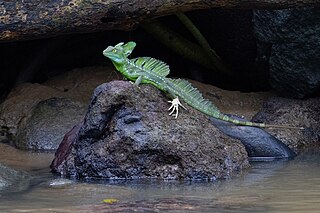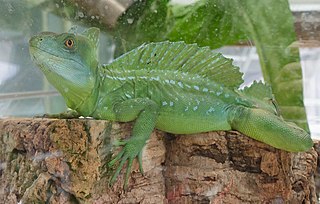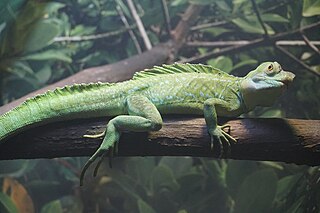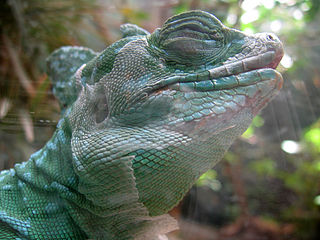- Home
- Best Pet for Me
- Basilisk Lizard Care
Your Essential Guide For Basilisk Lizard Care
 https://commons.wikimedia.org/wiki/File:Green_Basilisk.jpg
https://commons.wikimedia.org/wiki/File:Green_Basilisk.jpgFamiliarize yourself with basilisk lizard care before attempting to adopt one of these captivating creatures!
Basilisks are fascinating reptiles with several species kept as pets, but the vibrant Green Basilisk is the most popular.
Native to tropical climates, they love climbing and swimming, requiring ample space to satisfy these instincts. With their unique needs, they demand extra care, so only experienced reptile owners should consider taking on a basilisk.
Their environment must be spacious and enriched, ensuring they have the freedom to explore and thrive.
Basilisk Behavior: Calm and Non-Dangerous Pets
Basilisks are generally calm creatures, rarely resorting to biting or scratching.
They’re non-aggressive and completely harmless, as they lack venom.
These fascinating reptiles make great pets for those seeking a low-risk companion, known for their curious nature rather than any danger.
Basilisks Prefer Minimal Handling: Gentle Care for a Peaceful Pet
 https://commons.wikimedia.org/wiki/File:Plumed_basilisk.1.jpg
https://commons.wikimedia.org/wiki/File:Plumed_basilisk.1.jpgBasilisks may learn to tolerate handling, but they’re solitary creatures at heart and prefer minimal interaction.
When handling, always be gentle and cautious. Instead of frequent handling, it's best to enjoy watching them explore and thrive in their naturalistic enclosure.
Basilisk Sleep Habits: Create a Tree-Like Space with Plenty of Branches
Basilisks sleep at night, just like in the wild, where they rest high up in trees.
To replicate this natural behavior, provide plenty of branches in their enclosure, giving them a comfortable, tree-like space to rest and feel secure.
Basilisk Size: Males are Larger Than Females
Basilisks typically grow to 2-3 feet in length, with males reaching the larger end of this range. Females tend to be smaller, making for a noticeable size difference between the sexes.
Creating the Perfect Habitat: Maintain Warmth, Humidity, and Proper Lighting for Your Basilisk
 https://commons.wikimedia.org/wiki/File:Milwaukee_Public_Museum_March_2023_24_(Survival_of_the_Slowest--green_basilisk).jpg
https://commons.wikimedia.org/wiki/File:Milwaukee_Public_Museum_March_2023_24_(Survival_of_the_Slowest--green_basilisk).jpgTo create an ideal environment for your basilisk, maintain daytime temperatures in the 80s, with a basking area reaching 95°F.
At night, temperatures should stay above 75°F.
As rainforest natives, basilisks thrive in high humidity (55-75%), so regular misting, a waterfall, and a moist substrate are essential to keep the air moist and comfortable for your pet.
Basilisk Enclosure Setup: Spacious, Climbing Areas, and Water Features
 https://commons.wikimedia.org/wiki/File:Basilisk_Headshot.JPG
https://commons.wikimedia.org/wiki/File:Basilisk_Headshot.JPGFor the best basilisk lizard care, they need a lot of space in their enclosure.
They like to climb and swim, so areas for both of these activities is a necessity.
You should have a cage that is at least 3 feet long by 3 feet wide and 4 feet tall. About half of the bottom of the cage should be a pool that is deep enough for them to submerge themselves.
They like to be in the water and can hold their breath for quite a while.
They require lighting to simulate a 12-14 hour day. They also need supplementing with UV lights.
There should be lots of branches for them to climb on and plants for them to hide in. They will be relaxed in a plant-dense environment and the plants can help with the humidity.
It’s really important for them to be able to hide if they want to, so you’ll need lots of caves.
Also, provide them with ledges to hang out on.
The substrate should be something that helps with the moisture. Reptile soil, coconut coir, and peat moss are all good choices. Just make sure the substrate has no pesticides in it.
You should have only one basilisk in a cage. They like to be alone and will fight if there are other basilisks around.
Omnivorous Diet for Adult Basilisks: Daily Salads and Calcium-Dusted Insects
Adult basilisks are omnivores. They should have a salad every day and some insects a few times a week. The insects should be dusted with calcium and vitamin D.
Basilisk Lizard Care Lifespan and Health: Avoid Nose Banging and Ensure Comfort
Basilisks can live 10-15 years. They have similar health concerns that other reptiles have - metabolic bone disease, parasites, and respiratory issues.
A basilisk that is upset or bored might bang its nose against the glass of the enclosure. Sometimes they can injure their nose from the banging.
Make sure your basilisk has all the stimulation, enrichment, ability to hide if it wants, and comfort that it needs. It is better to prevent nose banging than to deal with the after-effects of it.
To find out about other reptile pets and pets of other species, return to the Best Pet For Me List.







New! Comments
Have your say about what you just read! Leave me a comment in the box below.